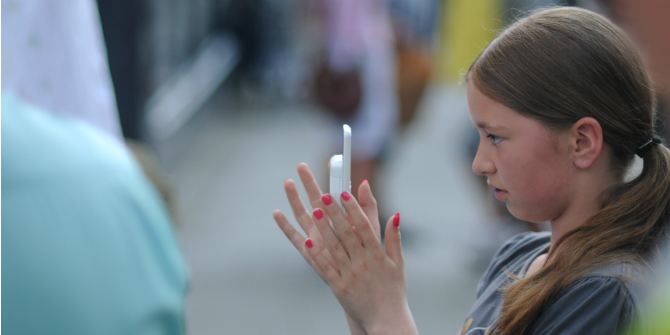 Previously we’ve shared some of our findings from our research with parents, educators, and children while we visited hands-on makerspaces through the San Francisco Bay Area as part of the Horizon 2020 funded international research project Makerspaces in Early Years (MakEY). To bring this series of posts to a close, we want to draw out some of the key policy implications that we have identified from this work. Although we have specific recommendations when it comes to involving parents, we also consider the value of makerspaces in general for young children, and in particular how issues of equity and access impact the experience of coming to makerspaces.
Previously we’ve shared some of our findings from our research with parents, educators, and children while we visited hands-on makerspaces through the San Francisco Bay Area as part of the Horizon 2020 funded international research project Makerspaces in Early Years (MakEY). To bring this series of posts to a close, we want to draw out some of the key policy implications that we have identified from this work. Although we have specific recommendations when it comes to involving parents, we also consider the value of makerspaces in general for young children, and in particular how issues of equity and access impact the experience of coming to makerspaces.
Makerspaces and inequality
In our previous posts we discussed the various motivations that lead parents to seek out makerspaces highlighting their interest in creativity and the freedom to learn through exploration and experimentation. Parents found that makerspaces helped children improve self-efficacy and critical thinking skills, in part by participating in collaborative, project-based learning (in many cases with parents themselves as the collaborators).
What is also important to note is that these are not just skills developed for here-and-now learning and development, but are seen both by parents and educators as fostering intrinsic capabilities that can have future career implications. The gap between high-income families and lower-income families participating in out-of-school learning activities despite wider recognition across all classes of their benefits has been well-documented. The most recent report from the Joan Ganz Cooney Center highlights how the reasons for lower participation rates among lower-income families is not just about money. Other factors have to do with a lack of communication and limitations on accessibility – not just in terms of geographic accessibility but also financial and/or other qualitative factors that mean that museum makerspaces may not be perceived as ‘for all.’
This is especially problematic in the San Francisco Bay Area, home to Silicon Valley and some of the US’s most striking inequality. These issues encompass housing and transportation – but also persistent gender and racial equity gaps, especially in the region’s lucrative tech industry. Thus while the makerspaces we visited were not immune to these realities – in all cases they had specifically worked to position themselves, wherever possible, as part of a new movement aimed at mitigating (if not eradicating) these issues. Thus we suggest policymakers look to some of these initial efforts from makerspaces when considering how hands-on making may be able to intercede in some intractable equity issues.

1. Access
Some of the museums we studied were more centrally located than others – e.g. the Tech Museum is in downtown San Jose easily accessible on foot or public transportation whereas the Bay Area Discovery Museum (BADM) is inaccessible except by private vehicle. That said, both museums (and the Lawrence Hall of Science) attempted to make their spaces as accessible as possible – even extending the museum ‘into the community’ in novel ways.
- Scheduling: By shifting or extending the hours of operations for makerspaces, parents who are currently unable to attend during traditional working hours or those who work weekends, such as many of those in the service sector, can bring their children.
- Physical access: given the limited transportation available to the museum, and the largely affluent communities they were surrounded by, BADM had developed a philanthropically-funded ‘Try it Truck’ (see image) which considerably extended the museum’s reach by creating a mobile makerspace that the educators could drive out to visit lower-income communities in the surrounding areas. When the truck visited these areas the educators often left behind free family passes to the museum (which also held free sessions on the first Wednesday of the month).
- Inclusive sessions: The Tech Museum has started holding ‘sensory friendly’ opening hours once a month as a way of ensuring that families with children who would not otherwise be able to attend the bustling museum could attend sessions. Most museums made assistive technologies and devices available to visitors (see image).
2. Communication
In order to build their capacity to engage young learners across the economic spectrum it is important that there is particular attention paid to spreading awareness of the spaces and benefits. The Bay Area is incredibly linguistically diverse with over one hundred different languages represented. This means it is important that the communication efforts for makerspaces are multi-lingual and tailored to the communities they serve. Although this varied, most museums had at least some (if not all) signage in multiple languages, although they did not necessarily have professional staff able to communicate in languages beyond English (and sometimes Spanish).
In addition to communication within the makerspace we also saw museums attempt to reach parents through other means – marketing, local parents forums and blogs, through fliers in schools. While these had some impact we didn’t see museums necessarily targeting specific community groups or associations within more linguistically diverse communities, this may be a helpful next step.
Equally, while many parents who arrived in the makerspaces were already relatively comfortable with the benefits of taking part, many could have used further prompts to understand the learning outcomes and how to ‘scaffold’ the learning in makerspaces into activities at home.
3. Funding
In order for people to reap the long-term benefits of makerspaces it is important that they are financially sustainable. This is especially true for longer-term forms of engagement beyond drop-in sessions (e.g. summer camps) and for the outreach work we noted was highly impactful, above.
We saw many makerspaces experimenting with different philanthropic funding models, although private philanthropy is not entirely unproblematic on this context. For example at the Tech Museum there were sponsored exhibits that allowed for the museum to run interactive on-going sessions and competitions in schools, although also introduced some industries for which there is some debate (e.g. aerospace engineering, AI). Although there is a potential for conflict of interest, we found that these models increased the museum’s capacity, but that some opportunities to then bring in new constituencies and experts could have been expanded upon – for example by linking to visits to the sponsoring businesses or other more advanced forms of outreach.
Recommendations
Although we recognise the impactful work being done by these museum makerspaces, and their already-stretched capacity, we nonetheless wish to conclude our project by offering a few thoughts for future consideration.
- Given physical access restrictions for some museums we recommend working with local companies – e.g. ride-sharing companies based in San Francisco, to subsidise ridesharing and vanpool options for families who do not have access to private transportation.
- We see an initial attempt to broaden the reach of makerspaces outside of the physical sites by working with external funders – often from the tech industries. We would like to see these partnerships deepen and include not just financial donations but also in-kind support through visiting experts, visits to company sites or even formal internship programmes. We would also recommend thinking more broadly than technology industries to consider locally relevant businesses for whom ‘making’ may also be a relevant pathway – for example food services, fashion, construction, agriculture or manufacturing.
- When working with funders it is important that both funder and grantee design their donations to be cognisant of the lifecycle of the makerspace in order to help sustain diversity and inclusion outreach. This means that seasonal projects may need to be repeated, or that donations should include not just core costs but also specialist personnel (e.g. special educational needs specialists, translators) to increase the impact of the interventions.
- Although it may not be practical in all circumstances we recommend identifying educators and volunteers who can speak the multiple languages of potential museum visitors – in addition to having signage in locally relevant languages.
Although this is a longer-term point, we also recommend that these makerspaces consider how parents might ‘scaffold’ the learning in the makerspace to activities at home more formally. One way of doing this might be to build on the ‘cheerleading’ that parents already do by creating a downloadable ‘maker journal’ that parents could use to document activities in the space and then prompt for more activities at home. This would also help in terms of communicating the benefits of making and encourage longer-term forms of engagement beyond what can be accomplished within a drop-in setting.
This post gives the views of the authors and does not represent the position of the LSE Parenting for a Digital Future blog, nor of the London School of Economics and Political Science.





